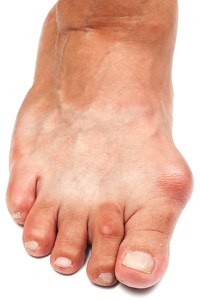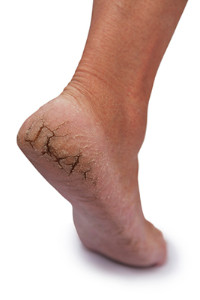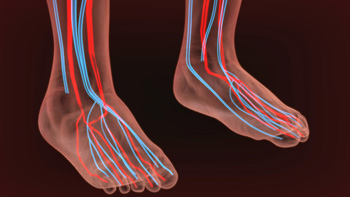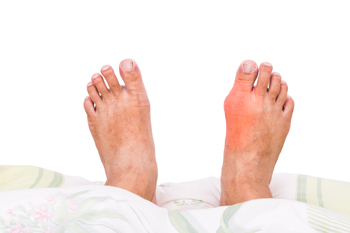Connect With Us
Blog
Items filtered by date: July 2019
How Do Bunions Develop?
 A large bony bump on the side of the big toe is referred to as a bunion. It can occur as a result of genetic factors, and from shoes that are worn which do not fit correctly. There may be inadequate room for the toes to move freely in, and this may cause the big toe to gravitate to the toe next to it. There are common symptoms that are often associated with bunions, including red and hardened skin over the affected toe, and it may be difficult to move and to wear shoes. Mild relief can be found when larger shoes are worn, and it may be helpful to wear a protective pad on top of the toe. For severe bunions, surgery could be a successful treatment option for permanent removal. If you are afflicted with a bunion, it is suggested that you seek the counsel of a podiatrist who can properly manage this condition.
A large bony bump on the side of the big toe is referred to as a bunion. It can occur as a result of genetic factors, and from shoes that are worn which do not fit correctly. There may be inadequate room for the toes to move freely in, and this may cause the big toe to gravitate to the toe next to it. There are common symptoms that are often associated with bunions, including red and hardened skin over the affected toe, and it may be difficult to move and to wear shoes. Mild relief can be found when larger shoes are worn, and it may be helpful to wear a protective pad on top of the toe. For severe bunions, surgery could be a successful treatment option for permanent removal. If you are afflicted with a bunion, it is suggested that you seek the counsel of a podiatrist who can properly manage this condition.
If you are suffering from bunion pain, contact Dr. Harry I. Zirna of Lockport Foot Care, PLLC. Dr. Zirna can provide the care you need to keep you pain-free and on your feet.
What Is a Bunion?
Bunions are painful bony bumps that usually develop on the inside of the foot at the joint of the big toe. As the deformity increases over time, it may become painful to walk and wear shoes. Women are more likely to exacerbate existing bunions since they often wear tight, narrow shoes that shift their toes together. Bunion pain can be relieved by wearing wider shoes with enough room for the toes.
Causes
- Genetics – some people inherit feet that are more prone to bunion development
- Inflammatory Conditions - rheumatoid arthritis and polio may cause bunion development
Symptoms
- Redness and inflammation
- Pain and tenderness
- Callus or corns on the bump
- Restricted motion in the big toe
In order to diagnose your bunion, your podiatrist may ask about your medical history, symptoms, and general health. Your doctor might also order an x-ray to take a closer look at your feet. Nonsurgical treatment options include orthotics, padding, icing, changes in footwear, and medication. If nonsurgical treatments don’t alleviate your bunion pain, surgery may be necessary.
If you have any questions, please feel free to contact our offices located in Lockport and Medina, NY. We offer the newest diagnostic and treatment technologies for all your foot care needs.
Read more about BunionsHow Do Bunions Develop?
 A large bony bump on the side of the big toe is referred to as a bunion. It can occur as a result of genetic factors, and from shoes that are worn which do not fit correctly. There may be inadequate room for the toes to move freely in, and this may cause the big toe to gravitate to the toe next to it. There are common symptoms that are often associated with bunions, including red and hardened skin over the affected toe, and it may be difficult to move and to wear shoes. Mild relief can be found when larger shoes are worn, and it may be helpful to wear a protective pad on top of the toe. For severe bunions, surgery could be a successful treatment option for permanent removal. If you are afflicted with a bunion, it is suggested that you seek the counsel of a podiatrist who can properly manage this condition.
A large bony bump on the side of the big toe is referred to as a bunion. It can occur as a result of genetic factors, and from shoes that are worn which do not fit correctly. There may be inadequate room for the toes to move freely in, and this may cause the big toe to gravitate to the toe next to it. There are common symptoms that are often associated with bunions, including red and hardened skin over the affected toe, and it may be difficult to move and to wear shoes. Mild relief can be found when larger shoes are worn, and it may be helpful to wear a protective pad on top of the toe. For severe bunions, surgery could be a successful treatment option for permanent removal. If you are afflicted with a bunion, it is suggested that you seek the counsel of a podiatrist who can properly manage this condition.
If you are suffering from bunion pain, contact Dr. Harry I. Zirna of Lockport Foot Care, PLLC. Dr. Zirna can provide the care you need to keep you pain-free and on your feet.
What Is a Bunion?
Bunions are painful bony bumps that usually develop on the inside of the foot at the joint of the big toe. As the deformity increases over time, it may become painful to walk and wear shoes. Women are more likely to exacerbate existing bunions since they often wear tight, narrow shoes that shift their toes together. Bunion pain can be relieved by wearing wider shoes with enough room for the toes.
Causes
- Genetics – some people inherit feet that are more prone to bunion development
- Inflammatory Conditions - rheumatoid arthritis and polio may cause bunion development
Symptoms
- Redness and inflammation
- Pain and tenderness
- Callus or corns on the bump
- Restricted motion in the big toe
In order to diagnose your bunion, your podiatrist may ask about your medical history, symptoms, and general health. Your doctor might also order an x-ray to take a closer look at your feet. Nonsurgical treatment options include orthotics, padding, icing, changes in footwear, and medication. If nonsurgical treatments don’t alleviate your bunion pain, surgery may be necessary.
If you have any questions, please feel free to contact our offices located in Lockport, NY . We offer the newest diagnostic and treatment technologies for all your foot care needs.
Possible Causes of Gout
The symptoms that many patients experience with the medical condition that is known as gout often include severe pain and discomfort, in addition to swelling on and around the big toe. The pain can be so disabling it can limit the ability to walk and to perform daily activities. This condition is caused by an excess of uric acid that is in the bloodstream, and can develop from eating foods that have large amounts of purines. These can include shellfish, red meat, alcohol, and drinks that are high in fructose. If certain medications are taken which can consist of water pills and low dose aspirin, it may lead to the development of gout. There are measures that can be implemented which may help to avoid gout attacks. These include eating limited amounts of red meat, and reducing alcohol intake. If you have developed gout, it is suggested that you consult with a podiatrist who can perform an accurate diagnosis and begin the correct treatment.
Gout is a foot condition that requires certain treatment and care. If you are seeking treatment, contact Dr. Harry I. Zirna from Lockport Foot Care, PLLC. Dr. Zirna will treat your foot and ankle needs.
What Is Gout?
Gout is a type of arthritis caused by a buildup of uric acid in the bloodstream. It often develops in the foot, especially the big toe area, although it can manifest in other parts of the body as well. Gout can make walking and standing very painful and is especially common in diabetics and the obese.
People typically get gout because of a poor diet. Genetic predisposition is also a factor. The children of parents who have had gout frequently have a chance of developing it themselves.
Gout can easily be identified by redness and inflammation of the big toe and the surrounding areas of the foot. Other symptoms include extreme fatigue, joint pain, and running high fevers. Sometimes corticosteroid drugs can be prescribed to treat gout, but the best way to combat this disease is to get more exercise and eat a better diet.
If you have any questions please feel free to contact our offices located in Lockport and Medina, NY. We offer the newest diagnostic and treatment technologies for all your foot and ankle needs.
Read more about Everything You Need to Know About GoutPossible Causes of Gout
The symptoms that many patients experience with the medical condition that is known as gout often include severe pain and discomfort, in addition to swelling on and around the big toe. The pain can be so disabling it can limit the ability to walk and to perform daily activities. This condition is caused by an excess of uric acid that is in the bloodstream, and can develop from eating foods that have large amounts of purines. These can include shellfish, red meat, alcohol, and drinks that are high in fructose. If certain medications are taken which can consist of water pills and low dose aspirin, it may lead to the development of gout. There are measures that can be implemented which may help to avoid gout attacks. These include eating limited amounts of red meat, and reducing alcohol intake. If you have developed gout, it is suggested that you consult with a podiatrist who can perform an accurate diagnosis and begin the correct treatment.
Gout is a foot condition that requires certain treatment and care. If you are seeking treatment, contact Dr. Harry I. Zirna from Lockport Foot Care, PLLC. Dr. Zirna will treat your foot and ankle needs.
What Is Gout?
Gout is a type of arthritis caused by a buildup of uric acid in the bloodstream. It often develops in the foot, especially the big toe area, although it can manifest in other parts of the body as well. Gout can make walking and standing very painful and is especially common in diabetics and the obese.
People typically get gout because of a poor diet. Genetic predisposition is also a factor. The children of parents who have had gout frequently have a chance of developing it themselves.
Gout can easily be identified by redness and inflammation of the big toe and the surrounding areas of the foot. Other symptoms include extreme fatigue, joint pain, and running high fevers. Sometimes corticosteroid drugs can be prescribed to treat gout, but the best way to combat this disease is to get more exercise and eat a better diet.
If you have any questions please feel free to contact our offices located in Lockport, NY . We offer the newest diagnostic and treatment technologies for all your foot and ankle needs.
Why Do Cracked Heels Occur?
 If the skin on the heels becomes dry, a condition that is known as cracked heels may develop. Deep cuts in the skin, which are referred to as fissures, may cause pain and discomfort, and it may be difficult to put weight on the feet. Common reasons why cracked heels may develop can include standing for extended periods of time for the majority of the day, and wearing shoes that have an open back. Additionally, if there are existing medical conditions that often include psoriasis and eczema, the chances of developing this ailment may increase. Mild relief may be found when the feet are washed and dried, followed by using a good moisturizer. If you have severely cracked heels, it is strongly advised that you seek the counsel of a podiatrist who can guide you toward the proper prevention and treatment techniques.
If the skin on the heels becomes dry, a condition that is known as cracked heels may develop. Deep cuts in the skin, which are referred to as fissures, may cause pain and discomfort, and it may be difficult to put weight on the feet. Common reasons why cracked heels may develop can include standing for extended periods of time for the majority of the day, and wearing shoes that have an open back. Additionally, if there are existing medical conditions that often include psoriasis and eczema, the chances of developing this ailment may increase. Mild relief may be found when the feet are washed and dried, followed by using a good moisturizer. If you have severely cracked heels, it is strongly advised that you seek the counsel of a podiatrist who can guide you toward the proper prevention and treatment techniques.
If the skin on your feet starts to crack, you may want to see a podiatrist to find treatment. If you have any concerns, contact Dr. Harry I. Zirna from Lockport Foot Care, PLLC. Dr. Zirna can provide the care you need to keep you pain-free and on your feet.
Cracked Heels
It is important to moisturize your cracked heels in order to prevent pain, bleeding, and infection. The reason cracked heels form is because the skin on the foot is too dry to support the immense pressure placed on them. When the foot expands, the dry skin on the foot begins to split.
Ways to Help Heal Them
- Invest in a good foot cream
- Try Using Petroleum Jelly
- Ease up on Soaps
- Drink Plenty of Water
Ways to Prevent Cracked Heels
- Moisturize After Showering
- Skip a Shower
- Keep Shower Water Lukewarm
- Don’t Scrub Your Feet
If you are unsure how to proceed in treating cracked heels, seek guidance from a podiatrist. Your doctor will help you with any questions or information you may need.
If you have any questions, please feel free to contact our offices located in Lockport and Medina, NY. We offer the newest diagnostic and treatment technologies for all your foot care needs.
Read more about Solutions for Cracked HeelsWhy Do Cracked Heels Occur?
 If the skin on the heels becomes dry, a condition that is known as cracked heels may develop. Deep cuts in the skin, which are referred to as fissures, may cause pain and discomfort, and it may be difficult to put weight on the feet. Common reasons why cracked heels may develop can include standing for extended periods of time for the majority of the day, and wearing shoes that have an open back. Additionally, if there are existing medical conditions that often include psoriasis and eczema, the chances of developing this ailment may increase. Mild relief may be found when the feet are washed and dried, followed by using a good moisturizer. If you have severely cracked heels, it is strongly advised that you seek the counsel of a podiatrist who can guide you toward the proper prevention and treatment techniques.
If the skin on the heels becomes dry, a condition that is known as cracked heels may develop. Deep cuts in the skin, which are referred to as fissures, may cause pain and discomfort, and it may be difficult to put weight on the feet. Common reasons why cracked heels may develop can include standing for extended periods of time for the majority of the day, and wearing shoes that have an open back. Additionally, if there are existing medical conditions that often include psoriasis and eczema, the chances of developing this ailment may increase. Mild relief may be found when the feet are washed and dried, followed by using a good moisturizer. If you have severely cracked heels, it is strongly advised that you seek the counsel of a podiatrist who can guide you toward the proper prevention and treatment techniques.
If the skin on your feet starts to crack, you may want to see a podiatrist to find treatment. If you have any concerns, contact Dr. Harry I. Zirna from Lockport Foot Care, PLLC. Dr. Zirna can provide the care you need to keep you pain-free and on your feet.
Cracked Heels
It is important to moisturize your cracked heels in order to prevent pain, bleeding, and infection. The reason cracked heels form is because the skin on the foot is too dry to support the immense pressure placed on them. When the foot expands, the dry skin on the foot begins to split.
Ways to Help Heal Them
- Invest in a good foot cream
- Try Using Petroleum Jelly
- Ease up on Soaps
- Drink Plenty of Water
Ways to Prevent Cracked Heels
- Moisturize After Showering
- Skip a Shower
- Keep Shower Water Lukewarm
- Don’t Scrub Your Feet
If you are unsure how to proceed in treating cracked heels, seek guidance from a podiatrist. Your doctor will help you with any questions or information you may need.
If you have any questions, please feel free to contact our offices located in Lockport, NY . We offer the newest diagnostic and treatment technologies for all your foot care needs.
It's Time for Beautiful Feet.
It's Time for Beautiful Feet
What Are Systemic Diseases of the Foot?
There are several systemic diseases that can  both display symptoms in the feet and impact the health of the feet. Common systemic diseases in the foot include gout, diabetes mellitus, arthritis and neurological disorders such as diabetic neuropathy and peripheral vascular disease. These can all have a significant impact on your feet. At the same time, these systemic diseases can be effectively treated to minimize both joint and muscle damage if they are diagnosed early and treated with medication. Diabetics with a systemic disease must closely monitor their blood sugar levels. People with arthritis that also have a systemic disease must ensure they are taking the proper treatments. If you feel you may have a systemic disease, it is important to see a podiatrist as soon as you can.
both display symptoms in the feet and impact the health of the feet. Common systemic diseases in the foot include gout, diabetes mellitus, arthritis and neurological disorders such as diabetic neuropathy and peripheral vascular disease. These can all have a significant impact on your feet. At the same time, these systemic diseases can be effectively treated to minimize both joint and muscle damage if they are diagnosed early and treated with medication. Diabetics with a systemic disease must closely monitor their blood sugar levels. People with arthritis that also have a systemic disease must ensure they are taking the proper treatments. If you feel you may have a systemic disease, it is important to see a podiatrist as soon as you can.
When dealing with systemic disease of the feet, it is extremely important to check the affected areas routinely so that any additional problems are caught quickly. If you have any concerns about your feet and ankles contact Dr. Harry I. Zirna from Lockport Foot Care, PLLC. Dr. Zirna will assist you with all of your podiatric needs.
Systemic Diseases of the Feet
Systemic diseases affect the whole body, and symptoms usually are displayed in the feet. This condition can make a patient’s ability to walk unbearable. Systemic diseases include gout, diabetes mellitus, neurological disorders, and arthritis.
Gout – is caused by an excess of uric acid in the body. Common symptoms include pain, inflammation, and redness at the metatarsal/phalangeal joint of the base big toe. Gout can be treated by NSAIDs to relieve pain and inflammation, and other drugs that lower the acid levels in the body.
Diabetes mellitus – is an increase in the level of blood sugar that the body cannot counteract with its own insulin. Failure to produce enough insulin is a factor in Diabetes.
Diabetes of the Feet
Diabetic Neuropathy – may lead to damaged nerves and affect the feet through numbness and loss of sensation.
Peripheral Vascular Disease – can restrict the blood flow to the feet, and often times lead to amputation of the feet.
If you have any questions please feel free to contact our offices located in Lockport and Medina, NY. We offer the newest diagnostic and treatment technologies for all your foot and ankle needs.
Read more about Systemic Diseases of the FootWhat Are Systemic Diseases of the Foot?
There are several systemic diseases that can  both display symptoms in the feet and impact the health of the feet. Common systemic diseases in the foot include gout, diabetes mellitus, arthritis and neurological disorders such as diabetic neuropathy and peripheral vascular disease. These can all have a significant impact on your feet. At the same time, these systemic diseases can be effectively treated to minimize both joint and muscle damage if they are diagnosed early and treated with medication. Diabetics with a systemic disease must closely monitor their blood sugar levels. People with arthritis that also have a systemic disease must ensure they are taking the proper treatments. If you feel you may have a systemic disease, it is important to see a podiatrist as soon as you can.
both display symptoms in the feet and impact the health of the feet. Common systemic diseases in the foot include gout, diabetes mellitus, arthritis and neurological disorders such as diabetic neuropathy and peripheral vascular disease. These can all have a significant impact on your feet. At the same time, these systemic diseases can be effectively treated to minimize both joint and muscle damage if they are diagnosed early and treated with medication. Diabetics with a systemic disease must closely monitor their blood sugar levels. People with arthritis that also have a systemic disease must ensure they are taking the proper treatments. If you feel you may have a systemic disease, it is important to see a podiatrist as soon as you can.
When dealing with systemic disease of the feet, it is extremely important to check the affected areas routinely so that any additional problems are caught quickly. If you have any concerns about your feet and ankles contact Dr. Harry I. Zirna from Lockport Foot Care, PLLC. Dr. Zirna will assist you with all of your podiatric needs.
Systemic Diseases of the Feet
Systemic diseases affect the whole body, and symptoms usually are displayed in the feet. This condition can make a patient’s ability to walk unbearable. Systemic diseases include gout, diabetes mellitus, neurological disorders, and arthritis.
Gout – is caused by an excess of uric acid in the body. Common symptoms include pain, inflammation, and redness at the metatarsal/phalangeal joint of the base big toe. Gout can be treated by NSAIDs to relieve pain and inflammation, and other drugs that lower the acid levels in the body.
Diabetes mellitus – is an increase in the level of blood sugar that the body cannot counteract with its own insulin. Failure to produce enough insulin is a factor in Diabetes.
Diabetes of the Feet
Diabetic Neuropathy – may lead to damaged nerves and affect the feet through numbness and loss of sensation.
Peripheral Vascular Disease – can restrict the blood flow to the feet, and often times lead to amputation of the feet.
If you have any questions please feel free to contact our offices located in Lockport, NY . We offer the newest diagnostic and treatment technologies for all your foot and ankle needs.
Blog Archives
- March 2024
- February 2024
- January 2024
- December 2023
- November 2023
- October 2023
- September 2023
- August 2023
- July 2023
- June 2023
- May 2023
- April 2023
- March 2023
- February 2023
- January 2023
- December 2022
- November 2022
- October 2022
- September 2022
- August 2022
- July 2022
- June 2022
- May 2022
- April 2022
- March 2022
- February 2022
- January 2022
- December 2021
- November 2021
- October 2021
- September 2021
- August 2021
- July 2021
- June 2021
- May 2021
- April 2021
- March 2021
- February 2021
- January 2021
- December 2020
- November 2020
- October 2020
- September 2020
- August 2020
- July 2020
- June 2020
- May 2020
- April 2020
- March 2020
- February 2020
- January 2020
- December 2019
- November 2019
- October 2019
- September 2019
- August 2019
- July 2019
- June 2019
- May 2019
- April 2019
- March 2019
- February 2019
- January 2019
- December 2018
- November 2018
- October 2018
- September 2018
- August 2018
- July 2018
- June 2018
- May 2018
- April 2018
- March 2018
- February 2018
- January 2018
- December 2017
- November 2017
- October 2017
- September 2017
- August 2017
- July 2017
- June 2017
- May 2017
- April 2017
- March 2017
- February 2017
- January 2017
- December 2016
- November 2016
- October 2016
- September 2016
- August 2016
- July 2016
- June 2016
- May 2016
- April 2016



